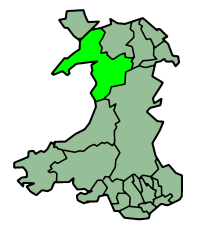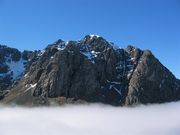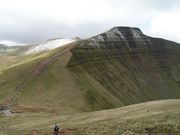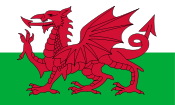Snowdon
| Snowdon (Yr Wyddfa) | |
|---|---|
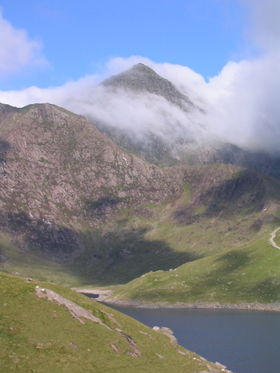 Snowdon seen from Llyn Llydaw |
|
| Elevation | 1,085 m (3,560 ft) |
| Prominence | 1,038 m (3,406 ft) Ranked 4th in British Isles |
| Parent peak | Ben Nevis |
| Listing | Marilyn (hill), Hewitt, Welsh 3000s, council top, Nuttall |
| Location | |
| Range | Snowdonia |
| Topo map | OS Landranger 115 |
| OS grid | SH609544 |
| Listed summits of Snowdon | ||||
| Name | Grid ref | Height | Status | |
|---|---|---|---|---|
| Crib y Ddysgl | SH610551 | 1,065 metres (3,494 ft) | Welsh 3000s, Hewitt, Nuttall | |
| Crib Goch | SH624551 | 923 metres (3,028 ft) | Welsh 3000s, Hewitt, Nuttall | |
| Craig Fach | SH635552 | 609 metres (1,998 ft) | sub Hewitt | |
Snowdon (Welsh: Yr Wyddfa, pronounced [əɾ ˈwɪðva]) is the highest mountain in Wales and is Great Britain's highest mountain south of the Scottish Highlands. It has been described as "probably the busiest mountain in Britain."[1] It is located in Snowdonia National Park (Parc Cenedlaethol Eryri) in Gwynedd. The summit is known as Yr Wyddfa ("the tumulus"[2]) and lies at an altitude of 1,085 metres (3,560 ft) above sea level. As the highest peak in Wales, Snowdon is one of three mountains climbed as part of the National Three Peaks Challenge.
The English name "Snowdon" comes from the Old English Snow Dun, meaning "snow hill" as Snowdon can offer significant falls of snow each winter from October to April, but in the past, rare fresh late-seasonal snow has been reported to fall on Snowdon, well into the months of May and June. Although the amount of snow on Snowdon in winter has varied significantly recently, 55% less snow had fallen in 2004 than in 1994.[3]
Snowdon has one of the wettest climates in Great Britain, receiving an annual average of more than 4,500 millimetres (180 in) of precipitation. The annual average temperature is estimated to be around +2.5 celsius.[4]
Contents |
First ascent
The first recorded ascent of Snowdon was by the botanist Thomas Johnson in 1639.[5] However, the 18th-century Welsh historian Thomas Pennant mentions a "triumphal fair upon this our chief of mountains" following Edward I's conquest of Wales in 1284, which, if true, indicates the possibility of earlier ascents.[6]
Climbing on Snowdon
The many steep cliffs in the Snowdon range are significant in the history of British rock climbing. The first recorded climb in the area was the 1798 ascent of the Eastern Terrace of Clogwyn Du'r Arddu (English: the black cliff of the dark(ness)) by the Reverends Peter Williams and W. Bingley, botanists looking for alpine plants. The north face of Y Lliwedd was explored in the late 19th century and in 1909 was the subject of the first British climbing guide, The Climbs on Lliwedd by J. M. A. Thompson and A. W. Andrews. Also, Edmund Hillary trained here for his climb up Mount Everest.
Topography
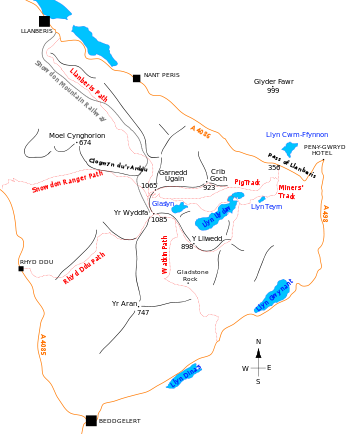
Legend
·black lines: ridges
·dotted red lines: paths
·orange lines: roads
·grey line: Snowdon Mountain Railway
Snowdon has six ridges:[7] these are steep and rocky to the north and east, shallower and grassy, but more remote to the south and west. There are many cwms formed by glaciation in the ice age, some filled with tarns (meltwater lakes). Subsidiary summits include Garnedd Ugain (1,065 m), the knife-edge summit of Crib Goch (923 m), Y Lliwedd (898 m) and Yr Aran (747 m).
Snowdon offers some of the most extensive views in the British Isles; on exceptionally clear days, Ireland, (the Republic of Ireland and Northern Ireland), Scotland, England, and the Isle of Man (as well as Wales) are all visible, as well as 24 counties, 29 lakes and 17 islands. From here, it is also possible to view the newly built Beetham Tower in Manchester and mountains of the Peak District and South Pennines that surround Manchester. The view between Snowdon and Merrick (southern Scotland) is the longest theoretical line of sight in the British Isles at 144 miles (232 km).[8] In practice atmospheric conditions make such sightings extremely rare. The mountain itself may also be viewed on take off and approach to both Manchester Airport and Liverpool John Lennon Airport on very clear days, and even from Howth Head in Dublin, Ireland.
Routes to the summit
A number of footpaths lead to Snowdon's summit from all sides,[9] and can be combined in various ways. The circular walk starting and ending at Pen-y-Pass and using the Crib Goch route and the route over Y Lliwedd is called the Snowdon Horseshoe. The routes are arranged here clockwise, starting with the paths leading from Pen-y-Pass. During winter, all these routes become significantly more difficult and many inexperienced walkers have been killed over the years attempting to climb the mountain via the main paths.
Crib Goch route
The Crib Goch route also starts at the Pen-y-Pass car park and initially follows the Pyg track before separating off from it at the Bwlch y Moch and leading up the side of Crib Goch. There is a bad step just before the ridge is reached, requiring a few handholds. From there the route follows the ridge of Crib Goch, over the summit of Garnedd Ugain and on to the summit of Snowdon. This forms half of the Snowdon Horseshoe route, the other half passing over Y Lliwedd (see below). It includes a very sharp ridge and requires some experience of scrambling and a head for heights. It should not be attempted in high winds or rain. In winter it is classed as a grade I/II mountaineering route requiring appropriate equipment and skills.
Pyg Track
The Pyg Track is a popular path leading from the car park at Pen-y-Pass along the lower slopes of Crib Goch before zig-zagging above the smaller lake Glaslyn to the col between Snowdon and Garnedd Ugain and thence to the summit of Snowdon.
Regarding the name of the Pyg Track, the web site of the Snowdonia National Park Authority states:[10]

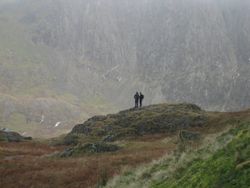
"No one is certain how the Pyg Track came by its name; possibly from Bwlch y Moch (Pigs' Pass) over which it passes. (It is sometimes spelt Pig Track). "Pyg" in Welsh also means 'pitch' and may refer to the dull black pitchy appearance of the path in one location; or it may have been the route used to carry pitch up to the copper mines. A third possibility is that it was named after the Pen-y-Gwryd Hotel nearby, by the early climbers who stayed there."
The Crib Goch route forks off upwards to the right from the Pyg route at Bwlch y Moch, whilst the Pyg route itself carries straight on, initially dropping down slightly onto a flatter section of path before the ascent towards the zig-zags. Some less experienced walkers have been known to get confused at this point, later finding themselves out of their depth on Crib Goch.
Miners' Track
The Miners' Track begins at the southern end of the Pen-y-Pass car park. After approximately 400m it passes above Llyn Teyrn and then continues for another kilometre before reaching the shore of Llyn Llydaw. After crossing Llyn Llydaw and following it around, the track rises more steeply and eventually leads to Glaslyn (English: blue/green lake). The final part of the Miners' Track consists of a scramble from the edge of Glaslyn onto the latter part of the Pyg track, although recent step-building has changed this considerably. The combination of ascent via the Pyg track and descent via the Miners' track is one of the most common ways of combining routes on Snowdon, due to their sharing a start point at the Pen-y-Pass car park.
Over Y Lliwedd
The southernmost of the paths leading from Pen-y-Pass leads up Y Lliwedd, to the south of Llyn Llydaw, and from there over Bwlch Ciliau (meaning variously "pass of corners/nooks" or "pass of retreat"), where the Watkin paths joins with it, to Snowdon itself. Shortly before the summit, this path merges with the Rhyd Ddu path. This is one half of the Snowdon Horseshoe, together with the Crib Goch route (see below). It includes a sharp ridge and requires some experience of scrambling and a head for heights.
Watkin Path
The Watkin Path has the greatest change in altitude out of all the paths up Snowdon. Starting at 60 metres (200 ft) above sea level at the Nantgwynant car park (SH628506) south of Snowdon, and finishing at Snowdon's 1,085 metres (3,560 ft) high summit, the Watkin Path has a height gain of 1,025 metres (3,363 ft). It follows the course of the Afon Cwm Llan river and passes the Gladstone Rock which commemorates the opening of the path in 1892 with a speech by William Ewart Gladstone, then Prime Minister, on Justice for Wales. The path then heads up the hillside to Cwm Ciliau (between Y Lliwedd and Snowdon) and onward to Snowdon. It is also possible to walk from Nantgwynant to Bwlch Cwm Llan, between Yr Aran and Snowdon and from there, either down to Rhyd Ddu or along Allt Maenderyn, along the top of the Clogwyn Du cliff face to meet the Rhyd Ddu path going to the summit. During the summer, apart from views of the surrounding Welsh countryside, plenty of tourists take to "cooling down" in the local waterfalls, part of the way up the path. The path was originally built by Sir Edward Watkin and extended in 2003 by the National Trust.
Scenes from Carry On Up The Khyber were filmed on the lower part of The Watkin Path (in Llanberis) in 1968, with The Watkin Path representing the Khyber Pass in the film. One of the stars of the film, Angela Douglas, unveiled a plaque at the precise location where filming took place in 2005 to commemorate the location filming and it forms part of the North Wales Film and Television Trail, run by the Wales Screen Commission.[11]
Rhyd Ddu Path
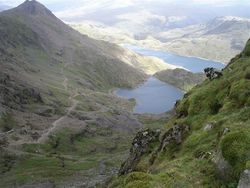
The Rhyd Ddu path leads from the village of Rhyd Ddu to the west of Snowdon, gently up on to Llechog, a broad ridge to leading west from the summit of Snowdon. This is one of the easier routes up Snowdon. It is also possible to walk from Rhyd Ddu to Bwlch Cwm Llan, between Yr Aran and Snowdon and from there, either down to Nantgwynant, or along Allt Maenderyn, along the top of the Clogwyn Du cliff face to meet the Rhyd Ddu path going to the summit. All walkers tread carefully at the last 100 metres (330 ft) or so because of a steep slope with scree. This is the path, but it is potentially dangerous.
Another branch, the Beddgelert branch or Pitt's Head path, begins at Pitt's Head on the A4085 road.
Snowdon Ranger Path
The Snowdon Ranger Path is named after an early mountain guide, John Morton, also known as "the Snowdon Ranger". His former home is now the Snowdon Ranger Youth Hostel. The path begins on the shores of Llyn Cwellyn, close to the youth hostel and Snowdon Ranger railway station. The path rises gently to Bwlch Cwm Brwynog, between Moel Cynghorion and Snowdon, and then along the top of the Clogwyn Du'r Arddu cliff face to Bwlch Glas between Snowdon and Garnedd Ugain.
Llanberis Path
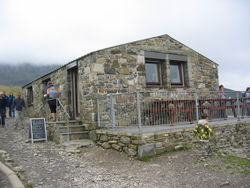
The Llanberis Path leads from Llanberis, approximately along the course of the Snowdon Mountain Railway. This is one of the longer routes up, although as the slope is mostly comparatively shallow, it is considered one of the easiest. It is also the path followed during the annual Snowdon Race (Welsh: Ras Yr Wyddfa). The first part of the path also leads to the well-known climbing cliff Clogwyn Du'r Arddu. Refreshments are available in a small café next to the path, about half-way up the mountain.
Snowdon Mountain Railway
For those who do not wish to or are not able to walk, or wish to walk one way only, the Snowdon Mountain Railway (a rack railway) runs from Llanberis to the top. A restaurant and shop can be found at the top station, just below the summit.
Summit buildings
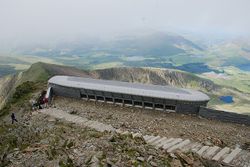
When the Snowdon Mountain Railway was opened in 1896, a hotel was built at the terminus, a short distance from the summit.
In the 1930s, this was replaced by a restaurant designed by Sir Clough Williams-Ellis. By the end of the twentieth century, this was run as a café and shop complex (selling, amongst other things, "I Climbed Snowdon" T-shirts). The building displayed a slate plaque with the following couplet: "Grwydryn, aros ennyd; ystyra ryfeddol waith Duw a'th daith fer ar y ddaear hon." ("Wanderer, wait a moment; consider God's wondrous work and your short journey on this earth.")
Becoming increasingly dilapidated, it was described by Prince Charles as "the highest slum in Wales." Its state led to a campaign to replace the building. In April 2006, Snowdonia National Park Authority with the support of the Snowdonia Society agreed a deal to start work on a new café and visitor centre complex.[12] By mid-October 2006 the old building had been largely demolished. The new RIBA Award-winning[13] £8.4 million visitor centre Hafod Eryri, designed by Ray Hole Architects in conjunction with Arup and built by Carillion, was officially opened on 12 June 2009[14] by First Minister Rhodri Morgan.[15] The Welsh National Poet, Gwyn Thomas, composed a new couplet for the new building, displayed at its entrance and on the windows, which reads "Copa'r Wyddfa : yr ydych chwi yma, yn nes at y nefoedd." ("The summit of Snowdon: you are here, nearer to Heaven.")[16]
The name Hafod Eryri was chosen from several hundred put forward after a competition was held by the BBC.[17]
References
- ↑ "About Us". Llanberis Mountain Rescue Team. http://www.llanberismountainrescue.co.uk/English/LLMRT%20HomePage2.html. Retrieved January 16, 2010.
- ↑ Cardiff University. "Welsh-English Lexicon". http://www.cs.cf.ac.uk/fun/welsh/LexiconForms.html. Retrieved 1 May 2006.
- ↑ "Snow 'disappears' from Snowdon". BBC News. 2004-12-20. http://news.bbc.co.uk/1/hi/wales/north_west/4112137.stm.
- ↑ "Weather and Climate in Wales". SouthTravels.com. http://www.southtravels.com/europe/wales/weather.html. Retrieved November 3, 2006.
- ↑ Terry Marsh (1984). The Summits of Snowdonia. London: Robert Hale. ISBN 0-7090-1456-2.
- ↑ Thomas Pennant (1778–1783). A Tour in Wales. Cited by Terry Marsh (1984). The Summits of Snowdonia. London: Robert Hale. ISBN 0-7090-1456-2.
- ↑ "Get-a-map". Ordnance Survey. http://getamap.ordnancesurvey.co.uk/getamap/frames.htm?mapAction=gaz&gazName=g&gazString=SH609544.
- ↑ Jonathan de Ferranti. "Computer-generated virtual panorama from Merrick". http://www.viewfinderpanoramas.org/panoramas/UPL/Merrick-S.gif. Retrieved 1 May 2006.
- ↑ "Routes to the Summit of Snowdon". Snowdon.com. http://www.snowdon.com/html/routes/routes.htm.
- ↑ "PYG Track". Snowdonia National Park Authority. 2005. http://snowdonia-npa.gov.uk/page/screen.php?nav1=recreation&nav2=11&nav3=4&nav4=1&nav5=1&level=1&lang=eng.
- ↑ "Carry On Plaque Unveiled". BBC News. 30 September 2005. http://news.bbc.co.uk/1/hi/wales/north_west/4296396.stm.
- ↑ "Snowdon centre deal agreed". Daily Post. April 6, 2006. http://icnorthwales.icnetwork.co.uk/news/regionalnews/tm_objectid=16911781&method=full&siteid=50142&headline=snowdon-centre-deal-agreed--name_page.html.
- ↑ "RIBA Awards 2010". RIBA. May 20, 2010. http://www.architecture.com/RegionsAndInternational/UKNationsAndRegions/Wales/Awards/RIBA%20Awards.aspx.
- ↑ "£8.4m Snowdon summit cafe opens". BBC News. June 12, 2009. http://news.bbc.co.uk/1/hi/wales/north_west/8095531.stm.
- ↑ "Summit cafe on Snowdon opened by First Minister Rhodri Morgan". Demotix. June 12, 2009. http://www.demotix.com/news/summit-cafe-snowdon-opened-first-minister-rhodri-morgan.
- ↑ . Y Cymro. July 13, 2007.
- ↑ http://news.bbc.co.uk/1/hi/wales/north_west/6173519.stm
External links
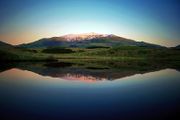
- Webcams from the Snowdon Weather Stations Project
- Walking Routes up Snowdon
- Mountain and Local Guide Snowdon.com
- Summit building construction blog
- Computer-generated virtual panoramas from Snowdon1: north; south
- Free printable contour map of Snowdon and the routes up download map
- Photos of Snowdon's summit on geograph.org.uk
|
|||||||||||
|
||||||||||||||||||||
|
||||||||||||||||||||||
|
|||||||
